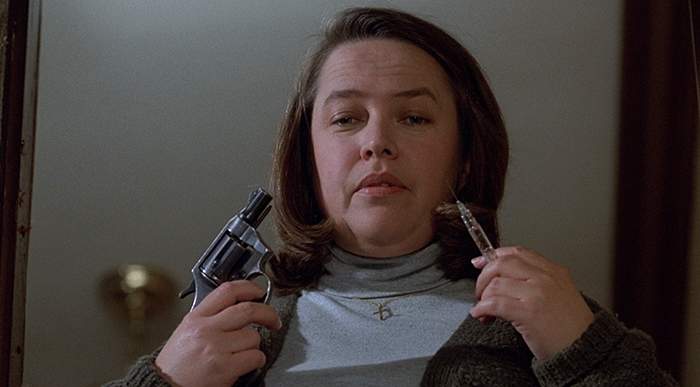The 1990 psychological thriller Misery is not supernatural, it doesn’t deal with the devil, and it doesn’t have eight sequels. In fact, it might not even be “horror” enough to be described as a horror film—there’s little blood and gore, and barely any “spooks.” The Rob Reiner flick, adapted from Stephen King’s 1987 novel of the same name, investigates the disturbing relationship between an injured romance author and a crazed caretaker fan. A quarter century later, it’s still arguably the scariest, most suspenseful movie of all time. Here are all the cockadoodie reasons why Misery is effing great. [Warning: Twenty-six-year-old spoilers ahead.]
Annie Wilkes is a totally grounded villain.
Annie Wilkes, the former nurse and “number one fan,” who obsesses over the character in a romance series, is almost too real. Wilkes’ violent mood changes, unpredictable behavior, and heightened rationale are chilling. Some have argued that this character reignited the “angel of death” trope in horror.
Kathy Bates earned a much deserved Oscar for her performance, making Misery the only Stephen King adaptation to win an Academy Award—and there have been some tremendous ones that have captured and affected culture far more than films that did win. Her transitions from naive, Christian schoolgirl to cold-blooded serial killer are seamless choices that made this performance both skin-crawling and legendary.
Fun fact: The women whom Annie Wilkes is based on, Genene Jones, is scheduled for release from a Texas prison this year. Yikes!
This monologue is beautifully acted and completely familiar if you’ve ever come in close contact with a person suffering from severe mental illness.
The suspense will make you cringe.
If you’ve never been terrified by a bobby pin or a porcelain penguin, strap in, because you’re in for an anxiety-riddled two hours. Director Rob Reiner has a knack for turning otherwise mundane moments into bloodcurdling fever dreams. And James Caan’s passive-aggressive handling of being treated like a prisoner makes the viewer feel validated in his choices—it’s not one of those horror movies where you’re screaming at the screen, “No, don’t open the door, moron!” Although the movie is now 26 years old, moments like the police walkthrough and the candlelit dinner still have us with our hands over our eyes.
Stephen King, why did you make paper-smudging so scary?!
The “hobbling” is one of cinema’s most visceral acts of violence.
Where other, less-patient horror movies feature skin-suit-making, limb-slicing, and disembowelment, Misery reminded us that breaking bones on screen is just as awful, if not worse. In one of the most disturbing scenes from the movie, Annie tells an escape-minded Paul how African diamond mine workers are typically punished if they run off with the goods. She then executes this gruesome punishment. I would not recommend watching this with a full stomach.
Richard Farnsworth slays as “Buster.”
On its own, Richard Farnsworth’s portrayal of the town Sheriff is worth watching Misery for. The character, brilliantly adapted by screenwriter William Goldman, very well could have been a total horror trope. In a lesser film, Buster, the folksy, cowboy-hat-wearing investigator would be incompetent and unprepared for Annie Wilkes’ horrors. But in Misery, the town sheriff is curiously intuitive and like a character out of Season 2 of Fargo. Honorable mention goes to Lauren Bacall as Paul Sheldon’s stressed-out literary agent from New York.
There’s a giant pig that defies expectations.
Most horror films that feature pigs also feature those pigs being sacrificed in a satanic ritual. In Misery, there’s just a super cute giant hog—named Misery, of course, after the character she obsesses over—who adds some comedic levity to the movie.
Misery hasn’t crossed over into camp, but it did inspire this campy viral video.
My love for Misery was re-ignited when this hilarious video of a woman freaking out at Barnes and Noble went viral this summer. Some horror movies, like Misery and The Shining, have the ability to remain scary for eternity. Others do not. At an outdoor screening of Roman Polanski’s classic Rosemary’s Baby in Bryant Park several years ago, the once-horrifying devil imagery caused the entire blanket section to erupt in laughter. Misery’s legacy, on the other hand, lives on in wonderfully campy tributes like the above video, which was made to promote a community theater production in Virginia back in 2011.
If you haven’t checked Misery out, you should! Just don’t watch it alone!











